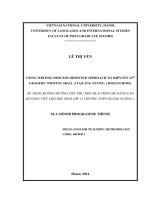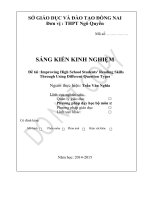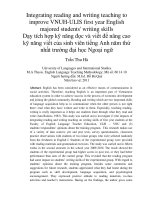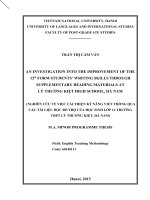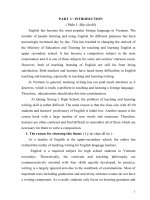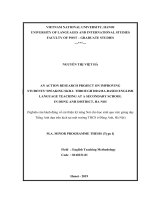IMPROVING STUDENTS’ WRITING SKILLS THROUGH PROCESS ORIENTED APPROACH
Bạn đang xem bản rút gọn của tài liệu. Xem và tải ngay bản đầy đủ của tài liệu tại đây (517.36 KB, 107 trang )
1
1
MINISTRY OF EDUCATION AND TRAINING
VINH UNIVERSITY
----------
LE THI THANH HUYEN
IMPROVING STUDENTS’ WRITING SKILLS
THROUGH PROCESS ORIENTED APPROACH
Major: Teaching English to Speakers of Other Languages
(TESOL)
Code: 60.14.01.11
MASTER THESIS IN EDUCATION
Supervisor: Nguyen Thi Quyet, Ph. D
NGHE AN - 2017
2
2
ACKNOWLEDGEMENTS
Foremost, I would like to express my sincere gratitude to my supervisor
Nguyen Thi Quyet, Ph.D for the continuous support of my research, for her
patience, motivation, enthusiasm, and immense knowledge. Her guidance
helped me in all the time of the research.
I would like to take this opportunity to express my gratitude to all my
lecturers at the Department of Post-graduate Studies, Department of Foreign
Languages, Vinh University, whose support and considerations have enabled
me to pursue the course.
I would also like to express my thanks to my colleagues at Quang Trung
Secondary School in Thanh Hoa who helped me in providing the materials,
collecting and analyzing data, as well as grading and evaluating the students’
tests.
I am also thankful to my students from two classes 8 A, 8 B at Quang
Trung Secondary School for their whole-hearted participation in the research.
Last but not least, I owe my sincere thanks to my parents, my younger
sister, my beloved husband who have always inspired and encouraged me to
complete this study.
3
3
STATEMENT OF AUTHORSHIP
I hereby acknowledge that this study is my own work. The data and
findings discussed in the thesis are true, used with permission, and have not
been published elsewhere.
Author
Le Thi Thanh Huyen
4
4
ABSTRACT
This study aims at investigating the effect of using the process oriented
approach to improve grade 8 students' writing skills at Quang Trung
Secondary School in Thanh Hoa. The purpose is to determine how the process
oriented approach can improve grade 8 students in writing skills and how
effective is the process writing approach in helping grade 8 students at Quang
Trung Secondary School in Thanh Hoa improve their writing habits and their
use of writing strategies. The study uses pre-questionnaire and postquestionnaire, pre-test and post-test as instruments to gather data.
The results of the study show that the process oriented approach has
positively improved grade 8 students’ writing skills at Quang Trung
Secondary School. It helps to bring about positive changes in most students’
attitudes towards writing and improvements in their writing habits. POA also
helps the students to improve their writing performance and to learn how to
use the strategies at each stage of the process of writing.
Based on the research results of this study, the researcher gives
pedagogical implications and suggestions to teachers and students in teaching
and learning writing.
5
5
TABLES OF CONTENTS
Page
6
6
LIST OF TABLES
Page
LIST OF FIGURES
Page
7
7
LIST OF ABBREVIATIONS
POA:
Process Oriented Approach
8
8
CHAPTER 1
INTRODUCTION
1.1 Rationale
Language learning in school is very much related to the four language
skills: listening, speaking, reading and writing. Among the four skills in
English lessons in secondary school, writing remains the commonest way of
examining student performance, especially for examinations. However,
according to recent test results from the Educational Testing Service (ETS),
writing has been the most problematic to Vietnamese test takers.
Teaching English writing in Vietnamese Secondary Schools is a
challenging job for many Vietnamese English teachers because it requires not
only high language competence among the teachers themselves, but also the
application of appropriate writing instruction.
Hoang Thuy (2009) says that most of the English teachers in Vietnam
find writing a complicated skill to teach, which, more or less, affects the
students’ learning outcomes. The problems of teaching EFL writing can be
found in such questions as how to make EFL students aware of why they
should write in English, how to teach students to write, how to give feedback
to students’ writing, and how to assess students’ writing skills.
In most writing classes at Quang Trung Secondary School, the teacher
usually provides learners with a topic and a related model text. The teacher
picks out sentences from the model texts for learners to study grammatical
structures; how and what to write are seldom discussed. The communicative
purpose and audience of the texts seem to be ignored. The teacher does not
focus much on the content of the model texts, but focuses more on the
language form. Learners use neither writing strategies nor the knowledge of
the writing process when they produce their own writing texts. Such a
9
9
teaching approach results in learners’ failure in producing a written text unless
the topic for writing is similar as the one they had been taught by their
teacher. Many learners do not pay attention to the communicative purpose and
audience of their writings; they just want to produce a text free of
grammatical mistakes. As a consequence, in writing classes, what learners can
produce is mostly an imitation of the model text given by their teacher with
the similar topic.
Besides, the teacher is considered the center of writing classes in many
settings in Vietnam. Interaction is commonly one way, from the teacher to
learners. The teacher provides knowledge and learners play the roles of
knowledge receivers and imitators, without many pair work or group work
activities. This results in the passive learning attitudes among learners. The
teacher does not provide learners with discovery tasks to stimulate their
participation and to integrate all the receptive and productive skills in the
classroom activities. Learners are supposed to reproduce what they have been
provided with to produce texts of similar topics.
In Vietnam, many EFL teachers focus on the correction of learners’
grammatical errors rather than communicative discourse when they assess
learners’ writings, even if these grammatical errors do not affect the meaning
conveyed. Learners who make grammatical mistakes will not earn high scores
even though they have good ideas. In contrast, learners who do not make any
mistakes with grammar could get better scores although their writings do not
seem to be communicative. For these reasons, learners tend to focus on
grammar in their writing as they expect their teachers to give them good
scores. However, focusing solely on grammar correction is not very helpful,
but even harmful in judging learners’ writing (Truscott, 1996) since a quality
piece of writing is more than just grammatically correct.
10
10
In addition, most writing activities in the Vietnamese secondary syllabus
are designed on the basis of the product oriented approach, in which students
are encouraged to mimic a model text, which is usually presented and
analyzed at an early stage. This discourages students’ creativity because they
cannot use their own experiences to express themselves. All they have to do is
to answer comprehension questions, to fill in the blanks with the provided
information, or to build complete sentences using the given cues in order to
make a meaningful letter, and so on. This controlled writing format hinders
teachers in trying new approaches in writing instruction. Teacher feedback
focuses more on grammatical and lexical errors instead of meaning oriented
exploration. In brief, under such a syllabus, students are mainly evaluated by
their test scores.
According to Assoc. Prof. Dr. Hoang Van Van (2007), the approach to
teaching writing in secondary schools is a combination of a number of
approaches (the controlled composition, the free writing approach, the
paragraph pattern approach, the communicative approach, and the process
approach), in which the communicative and the process approaches play a
dominant role. However, most language teachers in secondary schools still
adopt the product oriented approaches in the writing class because the writing
tasks in the textbook are presented on the base of controlled composition and
the paragraph pattern approach. These product oriented approaches, therefore,
have been the dominant mode of instruction in secondary school writing
classes, emphasizing students’ final pieces of work rather than the way how
they are produced.
As a result, students’ quality of EFL writing is evaluated on the basis of the
final product and grammatical and linguistic accuracy. Furthermore, due to this
product focus, students pay little attention to the whole process of writing and
11
11
they know very little about writing strategies. And to make the matter worse, the
interaction between a teacher and students or among students themselves does
not exist.
It is widely held that in secondary schools English teachers mainly
concentrate on the correction of grammar and spelling mistakes. They assume
that such errors need to be eradicated immediately, and that the best way to
help students is correcting all the errors in their writing in order to help
students make progress. However, this traditional treatment is said to have no
significant influence on students. From my observations, some good students
do not like such a way. They feel discouraged and humiliated when having
their writing papers marked with a lot of suggested correction. In some cases,
some students just take a glance at what the teacher has corrected, while many
others may not even look at the corrections.
Therefore, what English writing teachers in secondary schools need to do
is to improve the quality of students’ pieces of writing, to give them a more
cooperative learning environment, and to encourage them to share their
written products with their peers’.
To improve student’s writing skills at Quang Trung Secondary School,
the researcher has selected an approach – namely Process Oriented Approach
is one of the alternative approaches that can be used to solve the problems of
writing. Everyone knows that good product is also influenced very much by
good input and good process. Based on that statement, the researcher would
like to implement Process Oriented Approach in developing the learning
process of writing. Although the process oriented approach needs long
duration to implement, it will be useful as the medium to improve the
students’ skill in English writing
So, the researcher would like to conduct the experimental study
12
12
‘Improving students’ writing skills through process oriented approach’ in
order to develop and apply it in teaching writing skills. With the hope that can
improve the students’ motivation and writing results.
1.2. Aims of the study
The aims of my study are:
1. To see how the process oriented approach can improve the students’ writing
competence of grade 8 students at Quang Trung Secondary School in Thanh
Hoa.
2. To get how effective are the process oriented approach can improve writing
skills of grade 8 students at Quang Trung Secondary School in Thanh Hoa.
1.3. Research questions
In order to investigate that the process oriented approach can improve
the students’ writing competence and how effective are the process writing
approach in helping grade 8 students in writing skills at Quang Trung
Secondary School in Thanh Hoa. We would make an effort to find out the
answer to the following questions:
1. How
can process oriented approach improve grade 8 students in writing
performance at Quang Trung Secondary School in Thanh Hoa?
2. How effective is process oriented approach in helping grade 8 students at
Quang Trung Secondary School in Thanh Hoa improve:
Their writing habits
Their use of writing strategies?
1.4. Scope
of the study
This study is carried out with 60 students at Quang Trung Secondary
School in Thanh Hoa. All of these participants are in grade 8, thus they are
supposed to be at the same level of English proficiency. They are permanently
arranged in two separate classes 8 A, 8 B at Quang Trung Secondary School,
13
13
the researcher randomly chooses one for the control group and the other for
the experimental one. The researcher adapts the program of applying the
process oriented approach to teaching and learning English writing to find out
how can the process oriented approach improve students’ writing skills and
writing habits for grade 8 students at Quang Trung Secondary School.
1.5.
Methodology
The researcher uses the experimental method to conduct this study. To
collect data, the researcher uses questionnaires and tests to evaluate students’
writing skills. Pre- and post-questionnaires and pre-test and post-test are
conducted as follows:
Pre- and post-questionnaire on the students’ writing habits
The pre and post questionnaires on the students’ writing habits are
designed to investigate the students’ writing habits in both groups such as how
often students make a plan or an outline before start writing, how often
students revise the draft, edit the draft as well as share their writing with their
classmates.
Questionnaire on students’ evaluation of the writing process oriented
approach.
The questionnaire is designed for the experimental to investigate how
students like the writing process oriented approach, how useful of strategies
and how students manage strategies after program.
Pre- and post-test on English writing
To measure the quality of the participants’ written texts before and after
the research, the researcher has designed a pre-test and a post-test on English
writing. The test types selected for this study are popular kinds of similar to
writing tasks in the students’ book Tieng Anh 8 to those which students are
instructed, and those which are often used in the secondary school classroom
14
14
context.
1.6.
Significance of the study
It is hoped that this study can give some more concrete description of the
strength of the process orientated approach that can be used to solve the
problems of writing competence. Both teacher and students can get benefits
from the results of the research.
Teachers
The concept of the process oriented approach is necessary to be
recognized by the English teachers in order to develop teaching and learning
writing and make the writing process more interesting. It can also motivate
the teachers in making the preparation of different learning writing as
reference.
Students
By implementing the process oriented approach, the students will be
facilitated to write in English well so that writing skills are not difficult
anymore to do. In this case, the students are also motivated to express their
ideas through writing to communicate their thoughts to the readers.
School
The results of the study would bring about some benefits for school if it
is put in the school library as the reference. It is the important collection of the
literatures to support the teachers’ jobs in improving their instructions,
especially in writing. Besides, all readers can use the study to develop and to
consider what the teaching writing is.
1.7.
Organization of the research
15
15
The research consists of five chapters:
Chapter 1: Introduction- includes the rationale, the aims, the
methodology, the scope and the significance of the research.
Chapter 2: Theoretical background- presents the concepts and
definitions to be used in the research such as the meaning of teaching writing,
the meaning of POA, the implement of POA, the advantages of POA and the
disadvantages of POA.
Chapter 3: Methodology- presents the background information of the
subjects of the study, the instruments used to collect the data, the procedure of
data collection and data analysis
Chapter 4: Results and Findings - describes the data analysis in detail
and a thorough discussion of the findings of the study. Some explanations and
interpretations of the findings are also presented in this chapter.
Chapter 5: Conclusion - gives the summary of the findings and some
implications which are proposed for the teachers and the students in teaching
and learning writing.
The appendices lie at the end of the study, following the References.
16
16
CHAPTER 2
THEORETICAL BACKGROUNDS
2.1. Teaching writing
2.1.1. The Meaning of writing
It is necessary to expose the linguists’ opinions about writing. This is
used to consider what the accurate definition of writing is. Here are their
opinions about writing:
Ghazi (2002) says that writing is a complex process that allows writers
to explore thoughts and ideas, and makes them visible and concrete. Writing
encourages thinking and learning for it motivates communication and makes
thought available for reflection. When thought is written down, ideas can be
examined, reconsidered, added to, rearranged, and changed.
The above statement gives the language teachers signals that conducting
writing process is not as simple as other language skills – listening – reading
and speaking. It needs some skills, such as: (1) using vocabulary; (2)
generating the ideas; and (3) using tenses or grammar for writing. After doing
at least three skills, the product of writing should be examined, changed, and
edited to get the perfect writing. Writing performance is different from other
skills because it needs the accurate situation or context, and of course, the
structure of every sentence must be complete to avoid misunderstanding.
Heaton (1988, p. 135) says that the writing skills are complex and
sometimes difficult to teach, requiring mastery not only of grammatical and
rhetorical devices but also of conceptual and judgmental elements. There are
analysis attempts to group the many and varied skills necessary for writing
good prose into five general components or main areas. They are: (1)
language use – the ability to write correct and appropriate sentences; (2)
17
17
mechanical skills – the ability to use punctuation and spelling correctly; (3)
treatment of content – the ability to think creatively and develop thoughts; (4)
stylistic skills – the ability to manipulate sentences and paragraphs and use
language effectively, and (5) judgment skills – the ability to write in an
appropriate manner for a particular purpose with particular audience in mind,
together with an ability to select, organize and order relevant information.
Kathleen et al. (1996, p2) says that the ability to write involves the
components of writing. They are: (1) grammatical ability – the ability to write
English in grammatically correct sentence, (2) lexical abilities – the ability to
choose words that are correct and used appropriately, (3) mechanical ability –
the ability to correctly use punctuation-spelling-capitalization etc, (4) stylistic
skills – the ability to use sentences and paragraphs appropriately, (5)
organizational skills– the ability to organize written work according to the
conventions of English, including the order and selection of materials and (6)
judgment skills – the ability to make judgment about what appropriate
depending on task, the purpose of the writing, and the audience.
Moreover, Arndt (1988, p. 6) says that in writing process, there are six
activities can be done periodically. They are: (1) generating – brainstorming,
using questions, making notes, and using visuals and using role play or
simulation; (2) focusing – discovering main ideas, considering purpose,
considering audience, and considering form; (3) structuring – ordering
information, experimenting with arrangements, and relating structure to focal
idea; (4) drafting – drafting by the teacher and beginning, adding, ending; (5)
evaluating – assessing the drafts, responding, and conferencing; and (6)
reviewing – checking the context, checking connections, checking divisions,
assessing impact, editing, correcting, and marking, and taking final stock of
the product.
18
18
In terms of knowledge, Tribble (1996,p. 43) states that the range of
knowledge that a writer requires when undertaking a specific task can be
summarized in the following way: (1) content knowledge – knowledge of
concepts involved in the subject area; (2) context knowledge – knowledge of
context in which the text will be read; (3) language system knowledge –
knowledge of those aspects of the language system necessary for the
completion of the task; and (4) writing process knowledge – knowledge of the
most appropriate way of preparing for a specific writing task.
Furthermore, Tribble (1996, p. 130) says that in term of the writing
assessment, a text is not assessed in a single dimension but is viewed as being
the result of a complex of different skills and knowledge, each of which make
a significant contribution to the development of the whole. The five major
aspects of a piece of written work (content, organization, vocabulary,
language, and mechanics) are evaluated and each of these aspects is
accompanied by explicit descriptors of what is meant by band scale. A range
of possible scores is given for each band. These scores can be converted into
an overall grade.
Based on the linguists’ opinions above, it can be constructed that writing
skills are complex and sometimes difficult to teach, it requires not only high
language competence among the teachers themselves, but also the application
of appropriate writing instruction. In conclusion, before doing the writing
activity, the students must have the ability or prior knowledge in mastering
the components of writing to increase their writing ability. The writing
components should be mastered by students are:(1) grammatical ability – the
ability to write English in grammatically correct sentence, (2) lexical abilities
– the ability to choose words that are correct and used appropriately, (3)
mechanical ability – the ability to correctly use punctuation-spelling-
19
19
capitalization etc, (4) stylistic skills – the ability to use sentences and
paragraphs appropriately, and (5) organizational skills – the ability to organize
written work according to the conventions of English, including the order and
selection of materials. The students should master in writing components
before doing the writing process because writing is complex and needs a lot
of skills and knowledge. Hopefully, they can give the appropriate solutions in
students’ writing problems. These above writing components are also similar
to the writing components (content, organization, vocabulary, language, and
mechanics) that are stated by Tribble. As the reason, these components are
also more appropriate with the L2students.
2.1.2
Different approaches to teaching writing
In the recent history of second language writing, a number of different
approaches to the practice of writing skills have vied for the attention of
second language writing professionals. Among these approaches, the
controlled composition and the paragraph pattern approaches are the most
prominent and widely used in a series of new English textbooks for
Vietnamese secondary school students.
The controlled composition
The controlled composition sees language learning as a process of habit
formation. Thus, it is not surprising to see, within this tradition, that speaking
was its primary concern whereas writing was regarded as a secondary one and
specially served as reinforcement for oral habits.
In the controlled composition classroom, the primary focus is on formal
accuracy. The role of the teacher is to provide accurate and carefully selected
language samples that students can repeat and memorize. Besides, the teacher
can give structural frames within which students can do controlled
substitutions. So, for example, they may be asked to change all the present
20
20
tense verbs to past tense; in such a case, students may need to alter other time
references in the paragraph. Within this tradition, students can write a lot
without being afraid of making many errors, and the teacher can deal with
these pieces of writing more easily.
Overall, the controlled composition sees writing as a secondary activity;
as a means of practicing structures and vocabulary learned in the classroom.
Therefore, the context for writing is the classroom and the audience is the
teacher. This approach focuses on form and accuracy rather than the fluency
of the language, and writing is simply a means of assessing students’ ability to
manipulate the structures practiced in the classroom. Audience and purpose
are not taken into consideration.
The paragraph pattern approach
Increasing awareness of second language writers’ need to produce
extended written texts led to the realization that there was more to writing
than constructing grammatical sentences. The result of this realization was
what Raimes (2002) has called the ‘paragraph pattern approach’, which
emphasizes the importance of organization at the above-sentence level. This
approach owes much to Kaplan’s (1966) notion of ‘contrastive rhetoric’ – the
notion that writers’ different cultural and linguistic backgrounds will be
reflected in their ‘rhetoric’, with rhetoric typically seen as primarily a matter
of textual structure.
Within this tradition, the primary concern was the logical construction
and arrangement of discourse forms. In the early years, the paragraph was of
primary interest. Its focus was on its elements as well as options for its
development such as a topic sentence, supporting ideas, and a concluding
sentence. Another important concern was ‘essay’ development, which grew
from paragraph principles to complex texts. This involved larger structural
21
21
components, namely introduction, body and conclusion.
Classroom procedures associated with this tradition have tended to focus
students’ attention primarily on ‘form’. Students are asked to read and analyze
a model text and then write another piece of writing that has the same
organization with the original one. Besides, some common writing activities,
within this tradition, require students to group provided relevant facts,
rearrange them in the logical order to form an outline, and then write a
complete text based on that outline. Or sometimes, students may be asked to
complete a paragraph or a story by adding an ending or a beginning or a
middle section and so on.
In short, this tradition sees writing as basically a matter of arranging
sentences and paragraphs into particular patterns. Typical organizational
principles for materials include paragraph structuring, particularly related to
functional categories, and the use of a range of linking devices. Sentence level
and grammar practice is not omitted but is set in the context of a longer and
purposeful belief of language.
To sum up, these traditional approaches to the teaching of writing focus
on the product. In other words, this brief and generalized summary indicates
several trends in the ‘traditional’ teaching of writing:
• There is an emphasis on accuracy.
• The focus of attention is the finished product, whether a sentence or a whole
composition.
• The teacher’s role is to be the judge of the finished product.
•
Writing often has a consolidating function.
2.2. The
Meaning of POA
Recently, the teaching of writing has moved away from a concentration
on written product to an emphasis on the process of writing. In process
22
22
approach, students are trained to generate ideas for writing, think of the
purpose and audiences, and write multiple drafts in order to present written
products that are able to communicate their own ideas. Teachers who use this
approach give students opportunity to generate ideas and to give feedback on
the content of what they write in their drafts. Consequently, writing becomes a
process of discovery for the students as they discover new ideas and new
language forms to express them.
Montage (1995) says that the process oriented approach refers to a
teaching approach that focuses on the process a writer engages in when
constructing meaning. This teaching approach concludes with editing as a
final stage in text creation, rather than an initial one as in a product oriented
approach. The process oriented approach may include identified stages of the
writing process such as: pre-writing, writing and re-writing. Once the rough
draft has been created, it is polished into subsequent drafts with the assistance
of peer and teacher conferencing. Final editing and publication can follow if
the author chooses to publish their writing.
2.3. Review of Related Studies
The purpose of this review of related studies is to expose the other
studies which are similar to my subject of the study in order to get the
significant development and improvement done by other researchers. It is also
used to improve ones’ studies that needed to revise and to develop. These are
the studies conducted by the other researchers that have the benefits to support
my study so that it will give positive input to fulfill my study. The researchers’
study will be exposed as follows:
According to Nicole Montague (1995) says that the process oriented
approach refers to a teaching approach that focuses on the process a writer
engages in when constructing meaning. This teaching approach concludes
23
23
with editing as a final stage in text creation, rather than an initial one as in a
product oriented approach. The process oriented approach may include
identified stages of the writing process such as: pre-writing, while-writing and
post-writing. Once the rough draft has been created, it is polished into
subsequent drafts with the assistance of peer and teacher conferencing. Final
editing and publication can follow if the author chooses to publish their
writing. (Murray, 1972)
The study above gives the benefits of conducting the process oriented
approach in empowering the peers to polish the drafts in order to make the drafts
accurate based on the English standard. It means that the product of composing
will be better if the process can be done periodically and accurately. This study
focuses on process oriented approach because there are a lot of benefits to
improve writing competence.
Based on Bos (1988) that conducting writing study through process
oriented approach includes: (1) planning; (2) drafting; (3) revising and
editing; and (4) sharing and publication.
During planning, writers appear to engage in cognitive activities that
allow them to select topics, consider purposes and goals for writing, identify
their audience, decide upon voice, and generate provisional frameworks for
their pieces. These provisional plans can be informal in that little is written to
reflect the occurrence of these activities. For some writers and in some
instances, however, the planning stage is relatively formalized by the use of
written outlines or frames, lists of ideas, and themes or topic sentences.
Instructional implications for this stage of the composing process include the
importance of providing students time to plan, modeling the cognitive
processes involved in planning, and establishing writing activities that have
genuine purposes.
24
24
The second stage, drafting, involves the process of "putting ideas into
visible language" (Flower & Hayes, 1981, p. 373). Drafting, however, does
not preclude continued planning and revising of plans. Most expert writers
engage in extensive revision of their plans as they write. During drafting,
authors juggle numerous demands, including continued planning and
constructing of meaning, selecting vocabulary to express meaning; using
conventions of grammar, punctuation, and spelling; and executing motor tasks
of writing or typing. To the degree that conventions of writing and motor
tasks are at an automatic level, authors have more attention to devote to the
constructive processes involved in writing (Scardamalia & Bereiter, 1986).
Instructionally, teachers can assist writers by encouraging them during first
drafts to focus on writing their ideas and reducing their attention to writing
conventions. Teachers can also provide adequate time and support for students
to revise and edit after drafting.
The third stage, revising and editing, deals with readying the text to
share with an audience. Emphasis should be placed first on revising the ideas
to make the piece more coherent and clear. Then, editing for writing
conventions should follow (Calkins, 1986; Graves, 1983). In the revision
process, sharing the written piece with others is important because it assists
the author in realizing the readers' understanding of the piece. During this
stage, it is not uncommon to teach grammar and spelling concepts, but this
instruction tends to be more effective if taught in the context of the author's
actual text and purposes for writing (Kean, 1983). The tacit implication for
instruction is that editing for writing conventions represents only one part of
the writing process. Yet writing curricula in special education classes tend to
make instruction in these writing conventions the major if not exclusive focus
of instruction.
25
25
The last stage in the composing process is sharing and publication. It
gives value and worth to the entire process. It also provides students the
opportunity to receive feedback and to perceive themselves as authors
responding to an audience (Graves & Hansen,1983).
Bos’ study stresses a student centered instructional approach, emphasizes
an interactive model of composing, relies on descriptive analyses of the
composing process in conjunction with the generated products, and places
value on establishing "authentic" purposes for learning and writing. The
benefit of his study is to empower students competence dealt with process
oriented approach.
Other study that conducted by Nicola Holmes entitled “The use of a
process-oriented approach to facilitate the planning and production stages of
writing for adult students of English as a Foreign or Second Language” says
that for various reasons, as far as students (and teachers) are concerned,
writing usually appears an extremely daunting task. First of all, the main
focus when a writing task is assigned has traditionally been on the final
product. The need to produce a coherent, well-written text can be a great
source of stress to the writer if the intervening stages in the process of
creating this text are overlooked. Few native speaker writers, let alone EFL
student writers, can be expected to produce a highly structured text without
first going through various pre-writing and drafting stages. However, this has
not always been made clear to students of English as a Foreign Language,
who are still often assigned writing tasks with little advice or support on the
processes involved in completing them (Tribble, 1996).
In contrast, the researcher suggested that in writing process needs to
involve the students in writing process which covers pre-writing, guidance
and free outlining, drafting, and editing and revising. Empirically, by


